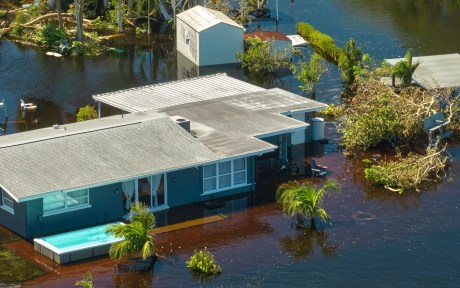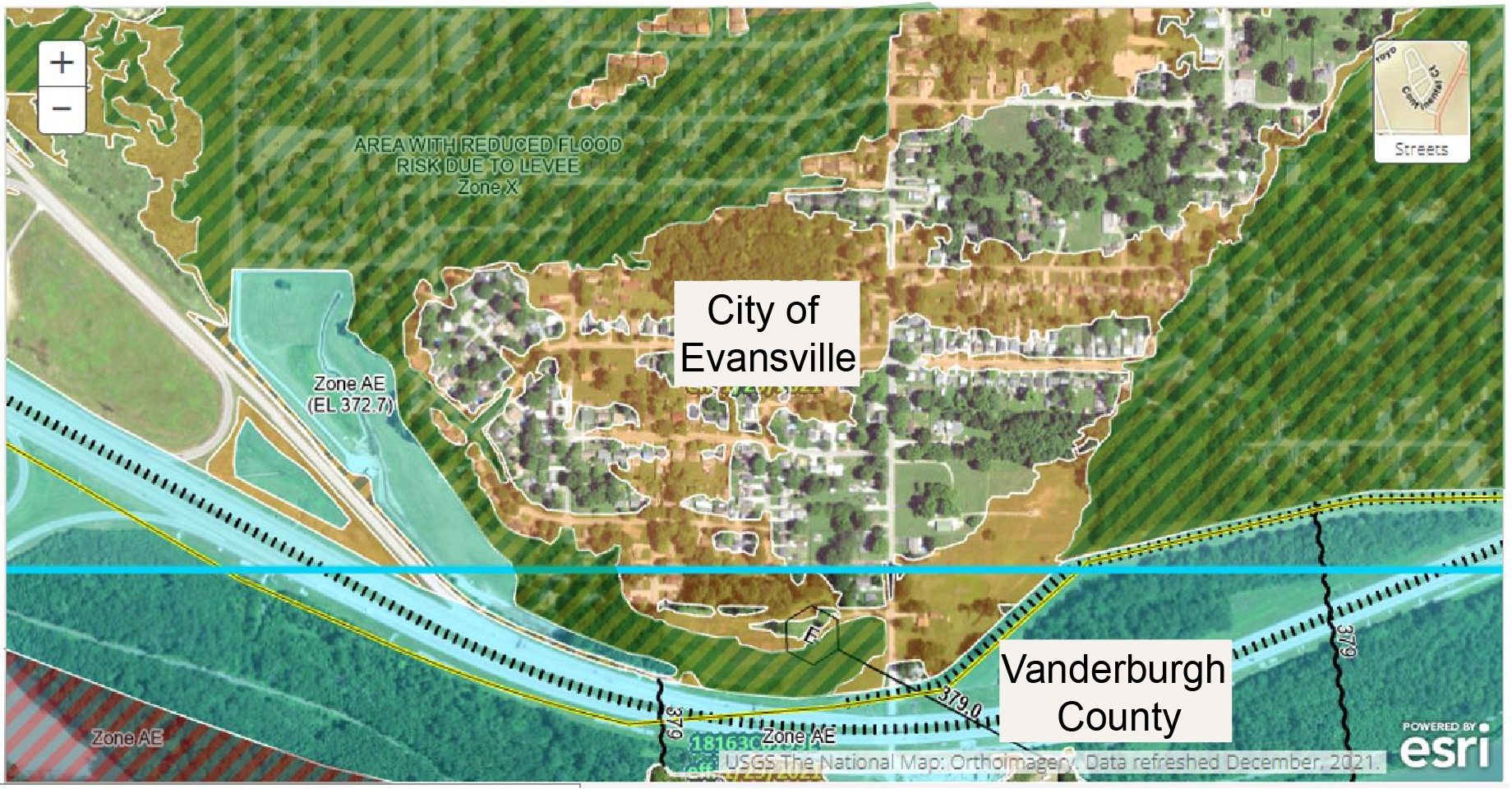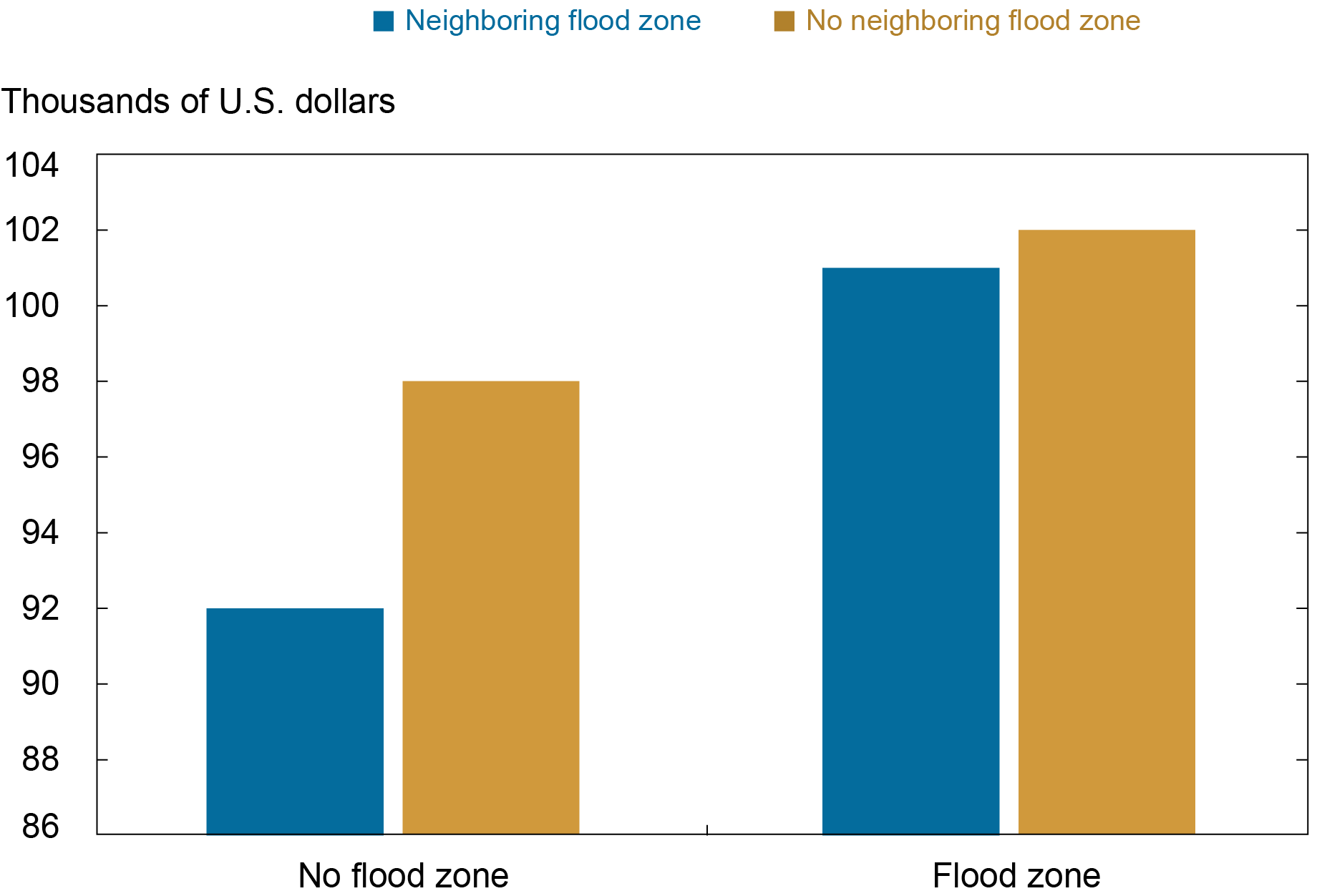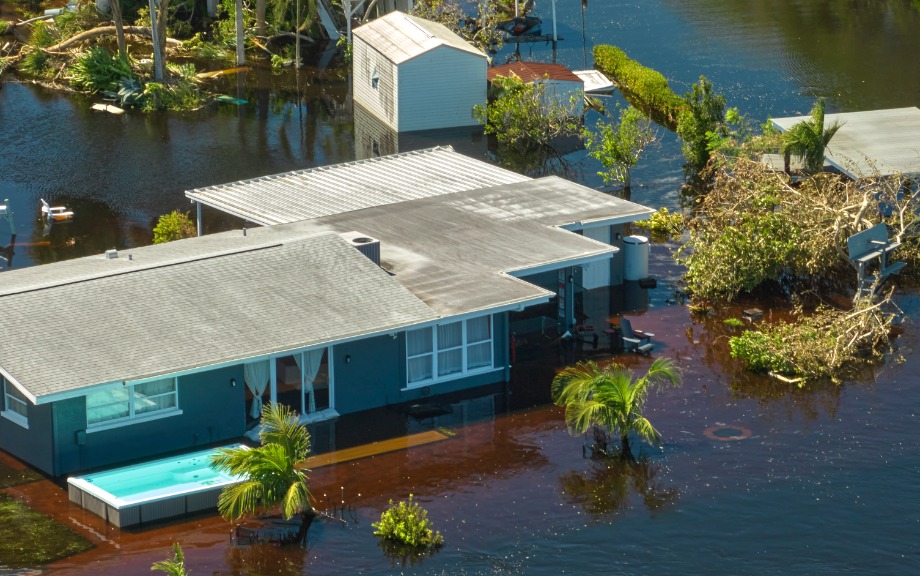
An often-overlooked side of flood-plain mapping is the truth that these maps designate stark boundaries, with households falling both inside or exterior of areas designated as “flood zones.” Households inside flood zones should insure themselves in opposition to the potential for disasters. Nonetheless, pricey insurance coverage might have pushed lower-income households out of areas formally designated a flood threat and into bodily adjoining areas. Whereas not designated an official flood threat, Federal Emergency Administration Company (FEMA) and catastrophe information reveals that these areas are nonetheless at appreciable threat of flooding. On this publish, we study whether or not flood maps might have inadvertently clustered these households financially much less in a position to bear the results of a catastrophe into areas which will nonetheless pose a major flood threat.
The Discrete Boundaries of FEMA Maps
The Nationwide Flood Insurance coverage Program (NFIP) was established in 1968, following devastating floods within the Mississippi Valley. This system was meant to assist decrease public publicity to potential losses ensuing from disastrous floods. Whereas this system had many different points, a key element was the creation of a Flood Insurance coverage Fee Map (FIRM). These maps of U.S. communities designated areas that FEMA thought-about to be liable to flooding “at the least as soon as each 100 years.” Households in these areas could be required to purchase particular flood insurance coverage in the event that they wished to qualify for an FHA/FHFA mortgage or any mortgage from a supervised monetary entity. We’ve mentioned this system itself—in addition to the probably unintended penalties of pricey insurance coverage contracts limiting water-adjacent dwelling to the very rich—in a earlier publish.
By their development, FEMA’s FIRM maps should designate areas as being both inside a “particular hazard” zone—and subsequently liable to flooding—or not. True flood threat, nonetheless, might not observe the identical discrete steps because the maps themselves do. In fact, FEMA each designates some areas as being in a “500-year” flood zone, that are areas liable to flood as soon as in 500 years, and supplies detailed threat evaluation scores of particular person census tracts. Nonetheless, these designations or threat scores are for info functions solely and don’t require potential dwelling patrons to buy costly insurance coverage contracts. Whereas some households do purchase flood insurance coverage even within the absence of an official mandate (NFIP information means that 20 p.c of all payouts are to households exterior of official flood zones), most don’t.

In a not too long ago up to date model of our paper on the “Unintended Penalties of Obligatory Flood Insurance coverage,” we digitize FEMA maps—present in addition to historic vintages—and assess the diploma to which any census tract within the U.S. is roofed by a particular flood hazard layer. We additional create a spatial database that particulars the flood threat confronted by neighboring and geographically proximate census tracts with comparable traits, earlier than merging the mixed information with detailed info on particular person mortgage candidates from the House Mortgage Disclosure Act information (HMDA).
Shopping for in a Flood Zone
We present that mortgage candidates are, all else equal, extra prone to be accepted by a lender exterior of flood zones. This end result holds independently of the true threat of flooding in an space, as measured by each previous disasters and third-party threat scores for the neighborhood. A median applicant is 2 proportion factors much less prone to be accepted by a lender if making use of in a flood zone. This distinction is sizeable, provided that we are able to account for all method of borrower traits together with credit score rating, revenue, race, and self-reported gender in addition to county and census tract traits. Nonetheless, a mortgage applicant with below-average revenue (relative to the county common) will likely be 5 p.c much less prone to be accepted in a flood zone in comparison with the identical applicant in an adjoining area that isn’t so designated.
On condition that flood maps have laborious boundaries, neighborhoods adjoining to areas coated by a flood map should still be liable to flooding. Utilizing FEMA’s personal threat scores for particular person census tracts in america, we are able to see that numerous areas with out flood maps (or designated a 500-year flood zone) would nonetheless fall into the very best class of precise “flood threat.” Within the chart beneath, we present that mortgage debtors in these areas have on common 8 p.c decrease incomes than their counterparts in neighboring areas with flood maps—regardless of dwelling with ostensibly the identical degree of threat.
Common Revenue in Census Tracts with Flood Threat

Notes: This chart depicts common incomes (winsorized to take away extremes) of accepted mortgage candidates in hundreds of U.S. {dollars} in census tracts with medium or excessive flood threat. All candidates in tracts with designated a flood zone (that’s, coated by 100-year flood maps) have larger incomes than their counterparts in the remainder of the nation. Nonetheless, households not coated by a flood zone that are adjoining to areas with a flood map see the bottom common revenue of census tracts on this group of areas with flood threat. This means a reshuffling of households might have taken place, with decrease revenue households pushed from areas mapped into flood zones into neighboring areas with out flood zones.
By wanting extra particularly at particular person candidates—and their traits in addition to their desired properties—in adjoining neighborhoods via the lens of a regression framework, we present that this downside is statistically vital. We discover that the common revenue of debtors within the unmapped areas remains to be 6 p.c decrease than the revenue of debtors within the instantly adjoining neighborhoods with a flood map, even once we account for regional and borrower-specific components. On condition that these comparable debtors are sometimes only some hundred ft aside and face nearly an identical dangers, this discovering is worrying. Importantly, our evaluation based mostly on modifications to those maps suggests these variations in revenue are probably associated to the necessary flood insurance coverage that comes with the flood-zone designation and never the results of longstanding variations between neighboring areas.
Conclusion
Our findings point out that flood mapping is related to larger borrower revenue in areas which might be designated a particular flood hazard zone. That is probably a mechanical response to the need of paying for comparatively costly insurance coverage. Nonetheless, we additionally discover that applicant revenue in neighboring areas is decrease than in mapped areas, regardless of these areas typically being equally dangerous. Furthermore, modifications to flood maps trigger modifications within the pool of candidates in mapped and neighboring areas, indicating that this can be a response to the mapping itself. These outcomes recommend that flood zone maps might cluster poorer households into dangerous areas which might be (as but) unmapped. This represents a substantial threat as these (uninsured) households could also be economically much less in a position to take care of the destructive penalties of a disastrous flood.

Kristian Blickle is a monetary analysis economist in Local weather Threat Research within the Federal Reserve Financial institution of New York’s Analysis and Statistics Group.

João A.C. Santos is the director of Monetary Intermediation Coverage Analysis within the Federal Reserve Financial institution of New York’s Analysis and Statistics Group.

Katherine Engelman is a knowledge scientist within the Information and Analytics Workplace within the Financial institution’s Expertise Group.

Theo Linnemann is a knowledge scientist within the Information and Analytics Workplace within the Financial institution’s Expertise Group.
Find out how to cite this publish:
Kristian Blickle, Katherine Engelman, Theo Linnemann, and João A.C. Santos, “Transferring Out of a Flood Zone? That Might Be Dangerous!,” Federal Reserve Financial institution of New York Liberty Road Economics, April 20, 2023, https://libertystreeteconomics.newyorkfed.org/2023/04/moving-out-of-a-flood-zone-that-may-be-risky/.
Disclaimer
The views expressed on this publish are these of the creator(s) and don’t essentially mirror the place of the Federal Reserve Financial institution of New York or the Federal Reserve System. Any errors or omissions are the accountability of the creator(s).

